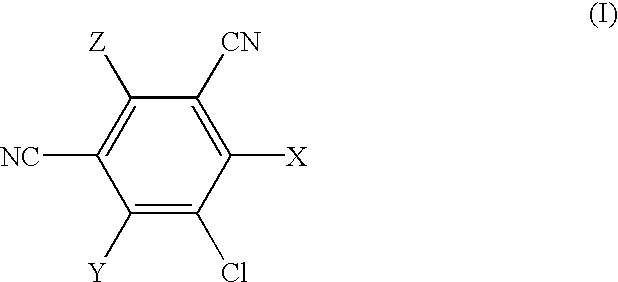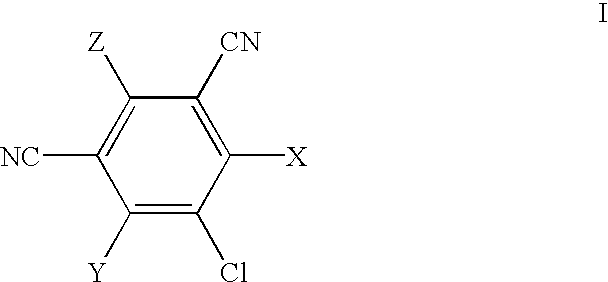Chiral stationary phases for enantiomers separation and their preparation
a technology of enantiomers and stationary phases, which is applied in the separation of optically active compounds, chemical/physical processes, peptides, etc., can solve the problems of limitations of all these products in their ability to enantiosel
- Summary
- Abstract
- Description
- Claims
- Application Information
AI Technical Summary
Problems solved by technology
Method used
Image
Examples
example 1
5-Chloro-4,6-di-[R-1-(naphth-1-yl)ethyl]amino-2-(3-triethoxysilylpropyl)amino-1,3-dicyanobenzene
The mixture of 2,4,5,6-tetrachloro-1,3-dicyanobenzene (2.0 g; 7.5 mmol) and [R-1-(naphth-1-yl)ethyl]amine (5.13 g; 30.0 mmol) is heated at 100.degree. C. in DMF (30 ml) for 48 hr. Then the solvent is evaporated to dryness, the crude product dissolved in toluene and purified by chromatography on silica gel column (100 g), using toluene as eluent. It is obtained 3.78 g (93%) of slightly yellow crystals of the pure product: 2,5-dichloro-4,6-di-[R-1-(naphth-1-yl)ethyl]amino-1,3-dicyanobenzene. The analysis of this product is as follows: Anal. calcd. for C.sub.32 H.sub.24 N.sub.4 Cl.sub.2 : C, 71.77; H, 4.51; and N, 10.4. Found: C, 71.72; H, 4.56; and N, 10.42%.
This compound (3.28 g, 6.13 mmol) in excess of 3-aminopropyltriethoxysilane (10.0 ml, 42.5 mmol) is heated at 110.degree. C. for 24 hrs. The solution is cooled to room temperature, diluted with toluene, applied on to flash chromatograph...
example 2
Chiral Stationary Phase FSC 1
The compound of example 1 (7.70 g; 10.6 mmol) and silica gel LiChrospher Si 100 (4.18 g) are heated under reflux in dry toluene over 72 hr. Chiral stationary phase FSC 1 (5.7 9) is isolated as pale-yellow amorphous material.
Analysis, found; C 17.81, H 2.00, N 2.77%. According to elemental analysis it is calculated that 0.21 mmol of the chiral selector is bound on 1.0 g of silica gel.
example 3
4-N-L-Phenylglycinyl-2,5,6-trichloro-1,3-dicyanobenzene
To 2,4,5,6-tetrachloro-1,3-dicyanobenzene (4.0 g, 15.0 mmol) in MeOH (100 ml) is added to a warm solution of L-phenylglycine (4.55 g, 30.0 mmol) and sodium carbonate (3.18 g, 30.0 mmol) in water (100 ml). The reaction mixture is stirred and heated under reflux for 1.5 hr, then cooled and filtered. The filtrate is acidified by addition of 1 M HCl (50 ml), and the precipitated product is separated by filtration. It is washed with water and dried in vacuo at ambient temperature. Crystallisation from ethanol afforded 1.40 g (25%) of pure product, white powder.
IR (KBr): 3500, 3320, 2220, 1715, 1570, 1500, 1450, 1380, 1310, 1290, 1260, 1210, 1180, 1120, 1070, 1040,1000, 960, 910, 860, 760, 720, 690 cm.sup.-1.
Anal. calcd. for C.sub.16 H.sub.8 N.sub.3 O.sub.2 Cl.sub.3 (380.60 g / mol): C, 50.48; H, 2.11; and N, 11.04. Found: C, 50.53; H, 2.36; and N, 10.86%.
PUM
| Property | Measurement | Unit |
|---|---|---|
| Temperature | aaaaa | aaaaa |
| Temperature | aaaaa | aaaaa |
| Mass | aaaaa | aaaaa |
Abstract
Description
Claims
Application Information
 Login to View More
Login to View More - R&D
- Intellectual Property
- Life Sciences
- Materials
- Tech Scout
- Unparalleled Data Quality
- Higher Quality Content
- 60% Fewer Hallucinations
Browse by: Latest US Patents, China's latest patents, Technical Efficacy Thesaurus, Application Domain, Technology Topic, Popular Technical Reports.
© 2025 PatSnap. All rights reserved.Legal|Privacy policy|Modern Slavery Act Transparency Statement|Sitemap|About US| Contact US: help@patsnap.com



